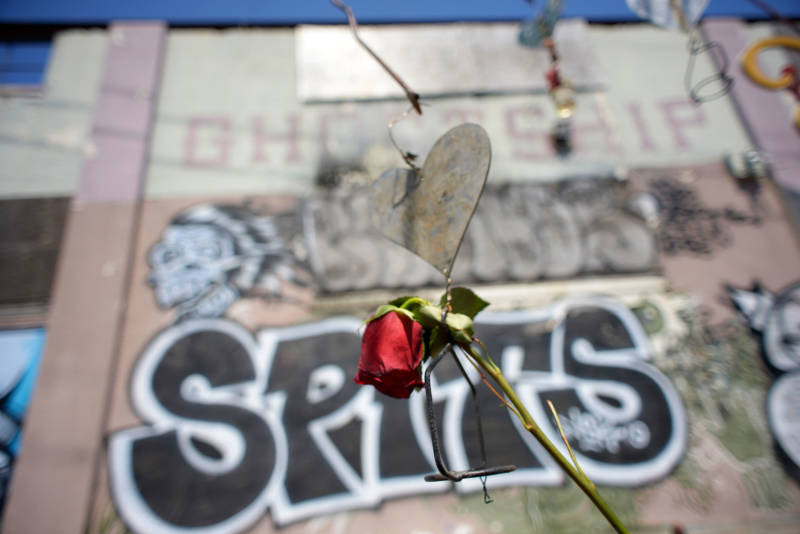Allison’s testimony on Tuesday began emotionally as she sat next to a large image of her family taken approximately six years earlier, which included Almena and their three children.
“That’s my family,” said Allison crying after Serra asked her to describe the photo.
Allison told Serra a number of safety improvements had been made at the building, including the removal of grates from the second-floor windows and the installation of a side door and front stairs. She said there were rules against smoking and open flames, including burning candles, in the building.
Alameda County Assistant District Attorney Casey Bates asked Allison during cross-examination Tuesday why there was a rule against open flames in the warehouse, and whether it was because the warehouse was a "combustible structure." Allison said the rule was implemented "for added safety." Asked if the "vast majority" of materials in the warehouse was wood or flammable, Allison said the interior was made up of "a lot of different materials."
Serra asked whether requests had been made to the landlords to make fire safety improvements to the building, to which Allison answered yes. She testified that Kai Ng, son of landlord Chor Ng, had visited the building at least three or four times in the years they had lived there, and that those visits occurred while others were living in the Ghost Ship at the time. She said the landlords had never personally told her to bring the building up to code.
Bates asked Allison during cross-examination if a number of modifications to the warehouse, including opening up a large hole in the second-level floor, had the required permits, to which she replied no. She also said inspections of those modifications didn't happen.
When asked by Serra how rent was established for tenants of the warehouse, Allison described it as "an organic process."
"It depended on the person and on what they could afford and the space," Allison said. She also testified that Almena set up arrangements with tenants to do house work, including cleaning, in exchange for reduced rent.
When Bates asked Allison who was responsible for interviewing potential tenants, she said, "Everybody, whoever was available." She said the interviewers typically included herself, Harris, Almena and sometimes others. She said three to four people would typically participate in the interview.
Allison said she and her husband generally shared a similar vision for the warehouse, as a space to create art and host theater, dance classes and workshops. She described it as a place “where traditional arts could be learned” and where experimental and multimedia art could be created inspired by traditional arts.
Allison also said Almena didn’t profit from events that were held in the warehouse.
Tyler Smith, who represents Harris, asked Allison if Harris had ever bossed anyone around, established rent, established live-work relationships or hired anyone from outside to make improvements to the warehouse. She said he hadn't.
Curtis Briggs, who also represents Harris, said these were several of the reasons his client should be acquitted.
Cross Examination of Allison Continues Wednesday; Two Defense Witnesses Testify
Under continued cross-examination by Bates on Wednesday, Allison reaffirmed that Sabatini arrived at the warehouse at approximately 10:00 a.m. to inspect the warehouse following a September 2014 couch fire outside of the warehouse. She said four to five other firefighters had also entered the warehouse.
Bates also asked Allison to identify fire escapes in a series of pictures of the Ghost Ship exterior, to which she said they were not visible. Under Bates' questioning, Allison indicated that only roof access was available.
Tony Serra called Thomas Cappel to the stand Wednesday. Cappel said he has been a friend of Almena's for 20 years, and had visited the Ghost Ship four to five times. Cappel described the warehouse as being undesirable when he first visited, but that later it became beautiful.
Asked by Serra if he ever felt like the warehouse was a fire hazard, Cappel said no. Under cross-examination from Alameda County Deputy District Attorney Autrey James, Cappel said he didn't know if the Ghost Ship had smoke detectors, alarms or sprinkler systems.
Serra also called on Daniel Keenan, who has been an Oakland firefighter since 1991.
Keenan testified he had helped his daughter move out of the warehouse in December 2013. Keenan said we went into the warehouse once to help her move a refrigerator out. He said he didn't find the warehouse to be cluttered at the time and didn't perceive any hazards in the warehouse.
This story includes reporting from Bay City News.

